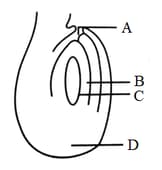EASY
Earn 100
What is Anatropous ovule example?
Important Questions on How do Organisms Reproduce
HARD
EASY
EASY
EASY
MEDIUM
EASY
Match column-I with column-II and select the correct option.
| Column-I | Column-II | ||
| a) | Megasporangium | i) | Accessory cells |
| b) | Inner integument | ii) | Embryo sac |
| c) | Antipodal | iii) | Ovule |
| d) | Female gametophyte | iv) | Tegmen |
MEDIUM
In ovules, a single megaspore mother cell
(a) Is generally differentiated in the micropylar region
(b) Is derived from integument
(c) Contains dense cytoplasm and prominent nucleus
EASY
EASY
MEDIUM
Study the following table and choose the correct option.
| Column-I | Column- II | ||
|---|---|---|---|
| (A) | Funiculus | (1) | Hilum |
| (B) | Scar of ovule | (2) | Tegmen |
| (C) | Zygote | (3) | Testa |
| (D) | Inner integument | (4) | Stalk of seed |
| (5) | Embryo |
MEDIUM

MEDIUM
MEDIUM
Match the columns, and select the correct option.
| Column – I | Column – II |
| (a) Hilum | (i) Parenchymatous tissue |
| (b) Micropyle | (ii) Female gametophyte |
| (c) Embryo sac | (iii) Junction between ovules and funicles |
| (d) Nucellus | (iv) Small opening present at the tip of the ovule |
EASY
MEDIUM
MEDIUM
EASY
MEDIUM
EASY
MEDIUM

